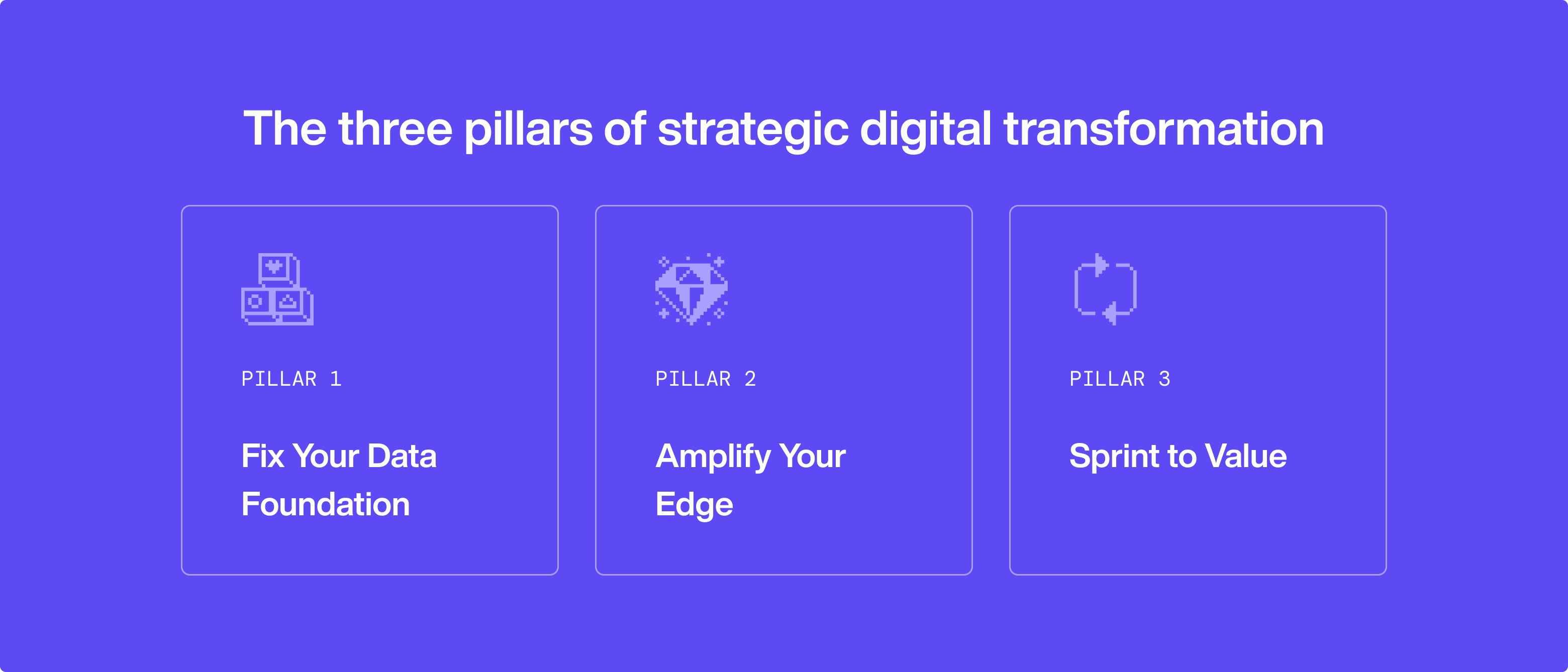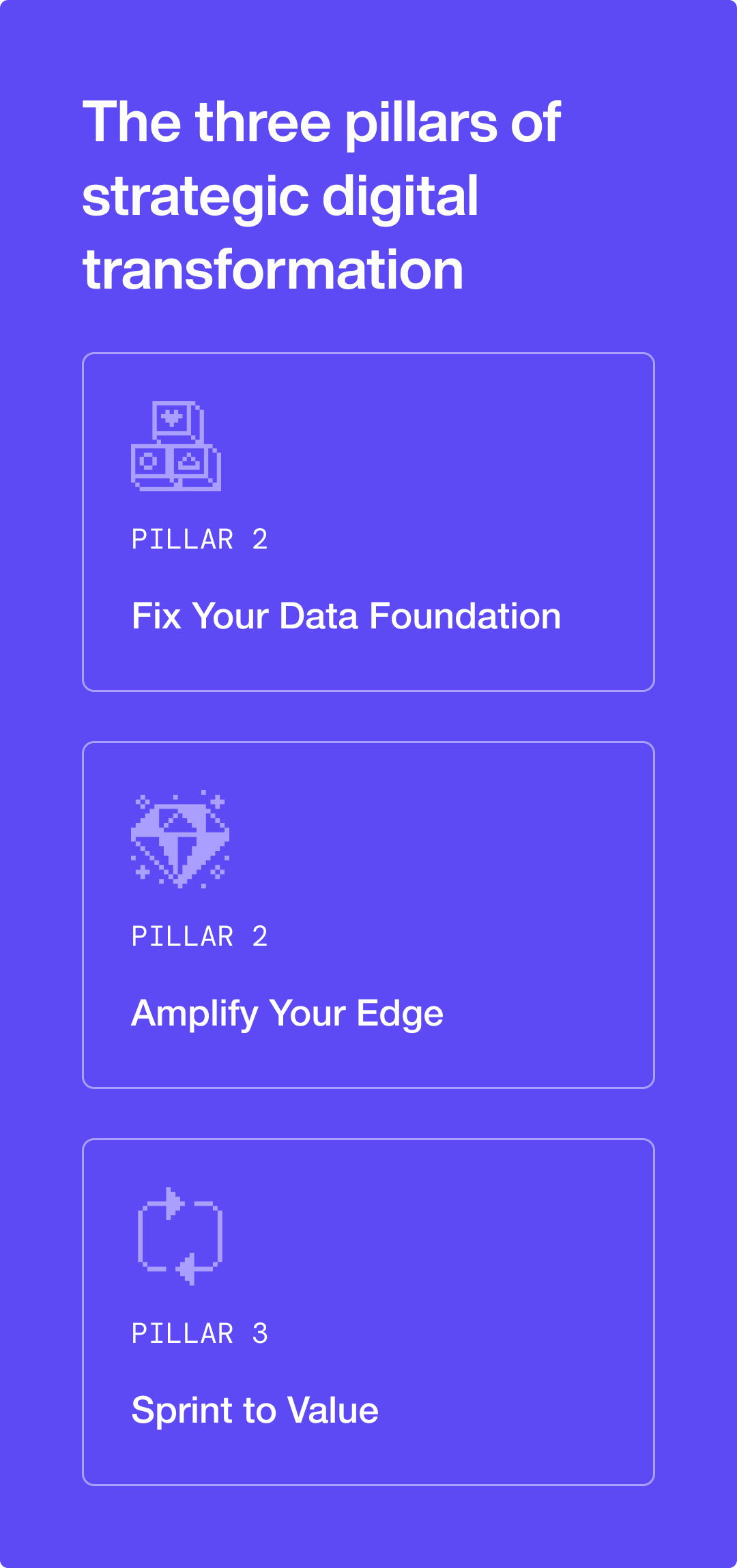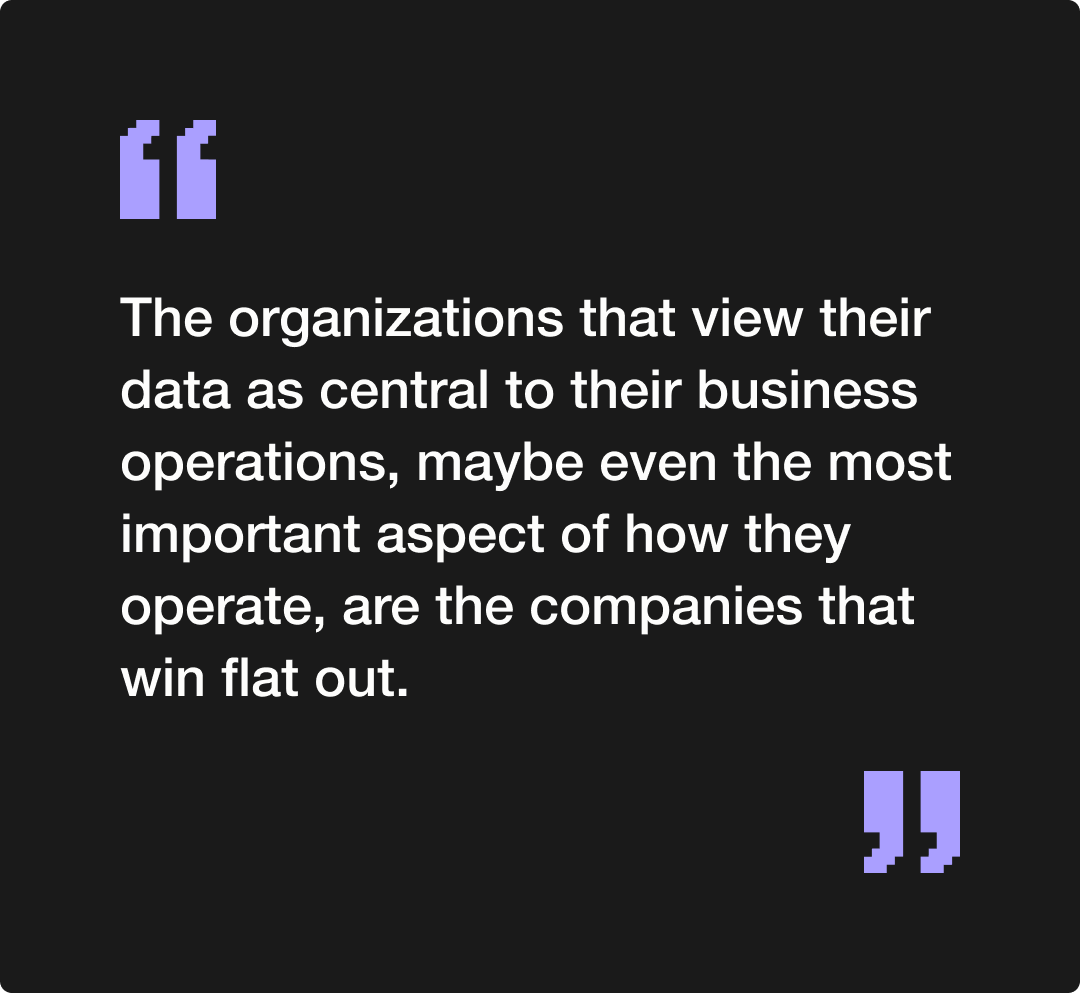Beyond the Hype:
A Three-Pillar Philosophy for Successful Digital Transformation
When you invest heavily in a lofty project like digital transformation, you expect to see success. Yet, the majority of digital transformation projects fail.
“60-70% of all digital transformation projects have failed over the last 10 years,” observes David Antoline.
Over the course of his 25 years in tech, he’s seen many organizations attribute this failure to the technologies they chose to adopt. In the aftermath, they’re left thinking:
- We should have selected AWS instead of Google Cloud
- Our database wasn’t ready for AI
- We picked the wrong customer relationship management (CRM) platform
However, the reality he’s uncovered is that digital transformation projects don’t fail due to technology choice. They fail because organizations select and implement these new tools before preparing an adequate data foundation and understanding their business reality.
Without accurate, organized data that reflects what stakeholders need to do their jobs effectively, efforts to transform and become AI-ready will inevitably collapse.
Key takeaways:
- Most digital transformation projects fail. This is often due to companies prioritizing technology selection over data foundation preparation.
- David’s three-pillar philosophy addresses these failures through data-first strategy, competitive tech alignment, and iterative delivery.
- By adopting this philosophy, organizations can count themselves among the 30% that succeed, rather than the 70% that fail.
The platform-first fallacy
The platform-first approach to transformation is rooted in the urgency surrounding modernization and AI readiness.
Under pressure to keep up with their more agile competitors, organizations select tools that promise enhancement — from cloud computing platforms to AI development platforms to business applications — without evaluating their data foundation first.
David notes that many companies have a fragile foundation, meaning the data they use to fuel their new technologies is inaccurate, incomplete, or irrelevant to the stakeholders who will need to use it. Additionally, organizations often assume that overhauling their entire tech ecosystem in one go is the fastest way to move forward and gain a competitive advantage.
By taking this extensive, platform-first approach, organizations with compromised foundations only discover their data issues after multi-year implementation projects have started. The discovery forces them to pause to get their data in order or abandon the project entirely, sometimes months or years in.
These disruptions result in organizations exhausting their budget on something that won’t generate ROI immediately, if at all. Meanwhile, they spend a significant amount of time away from focusing on core business activities that already generate revenue.
"It’s a double whammy,” David says. “You sink millions and millions of dollars into something that’s probably not going to succeed. And at the same time, you take your eye off of what has made your company competitive."


15-20% of revenue
Cost of data quality issues
7 - 12
Disconnected systems
3-6 month
Delays just to get basic
reporting
The three pillars of strategic digital transformation
Drawing from his decades of experience helping companies modernize their tech ecosystems, David shares that organizations must break with the “platform-first” mindset to succeed.
He’s learned that successful transformation endeavors rest on three key pillars.


Pillar 1: Fix Your Data Foundation
Organizations must establish a strong data foundation before implementing new technologies, especially AI platforms, David emphasizes.
However, cleansing, organizing, and storing their data properly is just one piece of the puzzle.
Beyond these practices, they should adopt the mindset that their data is a product like any other. This requires applying a product management mindset to data to understand what business users need to accomplish and develop data capabilities that align with those outcomes.
“The organizations that view their data as central to their business operations, maybe even the most important aspect of how they operate, are the companies that win flat out,” David states.


Pillar 2: Amplify Your Edge
When selecting new technologies to deploy, David warns organizations not to adopt “tech for the sake of tech” by chasing trends or blindly replicating competitor strategies.
It’s important to pay attention to how others adapt, especially in the face of rapid AI development. However, organizations should not let that distract them from zeroing in on their unique differentiator — whether it’s speed, scale, relationships, or data — and choosing technologies that reinforce that moat.
“Think about what your competitive advantage is,” David advises. “Then go back to your roadmap, look at what you have planned for the next 3, 6, 12 months, and determine whether it amplifies that advantage.”
Pillar 3: Sprint to Value
Organizations should also break transformation initiatives into smaller, more manageable chunks instead of moving to replace their tech ecosystem all at once.
David recommends tackling transformation in repeated six-week sprints that deliver measurable value. The iterative nature of the process can help them continuously determine whether they’re moving in the right direction and progressively solve more complex problems, while minimizing the cost of failure at any given stage.
“If you can’t produce some level of outcome that actually moves the ball forward in six weeks, you are probably wasting your time,” he says.
Want to learn how the six-week sprint can help you get your data foundation in order? Check out our tactical guide.


Joining the 30% club
The platform-first mindset is a significant contributor to the 70% failure rate for digital transformation initiatives.
By cutting through market noise and focusing on David’s three pillars, organizations can ensure they fall on the other side of the statistic and count themselves among the 30% that succeed.
With a strong data foundation, the right technologies, and a focus on rapid value delivery at implementation, organizations will be 20% more likely to see meaningful results from their digital transformation efforts. When they use a holistic framework that prioritizes data foundations, they’ll find themselves:
Moving forward with a proactive data strategy, rather than grappling with reactive data firefighting that disrupts progress and takes time away from the core business.
Building a sustainable competitive advantage, instead of pouring their resources into advanced technologies, like AI platforms, that only drive generic improvements.
Creating organizational confidence in the mission, not introducing uncertainty with extended, high-risk implementation timelines.
The three-pillar framework serves as a launchpad for successful digital transformation.




Let's start with a diagnostic.
- Custom mapping of risks, integration points, and tech gaps
- Actionable follow-up playbook if there's a fit










